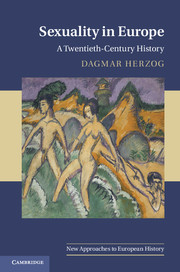1 - Reconceiving sexuality 1900???1914
Published online by Cambridge University Press: 05 June 2012
Summary
At the turn from the nineteenth to the twentieth century, a number of factors came together to make sex a highly public topic. One factor was growing media attention to the issue of prostitution. This attention was intensified by military and government authorities’ worry about the perceived spread of venereal diseases, and by public fascination with titillating stories of sex trafficking. The rise of a women's movement also spiked concern with prostitution. The movement challenged the entirety of the entrenched double standard of sexual morality, and above all expressed anger at the nonchalance with which authorities and the male public alike appeared to accept prostitution as simply a natural supplement to the institution of marriage. A second crucial factor was the growing desire for fertility control. Across European nations, couples sought to limit family size using a variety of measures and, despite the fact that contraceptive strategies often clashed with longings for pleasure, birthrates in all nations and all classes of society began dropping. Medical doctors and government authorities alike paid close attention to this phenomenon. Intersecting with these two developments was a third: an increasing voyeuristic public interest in scandals surrounding same-sex activities – many of them involving high-ranking military officials, members of the aristocratic elites, and celebrities. What once had been a rather unremarkable feature of some individuals’ sexual habits became fodder for mass gossip. Same-sex scandals also fueled speculation about human sexual predilections more generally – as, at the same time, increased efforts at policing and repression of same-sex activities were met with newly organized resistance from individuals who came to think of their preferences as an important part of their identities.
- Type
- Chapter
- Information
- Sexuality in EuropeA Twentieth-Century History, pp. 6 - 44Publisher: Cambridge University PressPrint publication year: 2011

